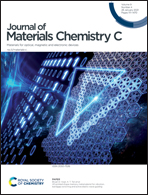High-performance near-infrared photodetectors based on C3N quantum dots integrated with single-crystal graphene†
Abstract
Quantum dots (QDs) integrated with two-dimensional (2D) nanomaterials hold potential use in photodetector devices due to the unique light absorption of QDs and excellent carrier transport properties of 2D nanomaterials. A simple strategy to fabricate hybrid graphene and QD photodetectors using a single-crystal monolayer graphene film as a carrier channel at the top and perfectly wrapping it to be in contact with the bottom layer of C3N QDs is developed. This strategy can lead to a tight contact between C3N QDs and the graphene interface, thus facilitating an efficient collection of all photo-generated carriers. Photodetectors, employing C3N QDs integrated with single-crystal graphene, exhibited distinct photocurrent response with high responsivity and detectivity at 1550 nm. The photocurrent map and simulated electric field distribution reveal the fast response and recovery, indicating that C3N QDs enhanced the local electric field near graphene. The present research indicates the strategy of combining hybrid architectures for optoelectronic devices to improve their performance thereof.



 Please wait while we load your content...
Please wait while we load your content...